I’m standing in front of the huge window at the east end of Balliol College dining hall. There in prime position, right at the top is a burning wheel. It is a striking image, and one which can be found all over Oxford.
Because this is a nod to one of the city’s favourite saints: Catherine of Alexandria. And on the weekend of her saint’s day November 25th I am on a mission to find out who she is and why she is memorialised here in the middle of England, such a very long way away from the place of her birth.
The story goes that Catherine, a young Egyptian noblewoman from the 5th century, had been converted to Christianity after she saw a vision of the Madonna and Child. Increasingly troubled by the persecution of Christians within the Roman Empire she approaches the Emperor Maxentius, who summons 50 of his most eminent pagan philosophers to debate with her on the subject. Intelligent, highly educated and filled with the passion of her beliefs she wins hands down, converting many in the process, including the watching Mrs Maxentius. Retribution is swift. The Emperor has the entire audience burned alive. Even his other half. And then Maxentius offers to marry Catherine in her place. She declines, announcing she is already betrothed to Christ. Maxentius is furious. He orders her to be broken on the wheel, a method of execution used well into medieval times that involves tying the victim to a spiked wheel, and then either bludgeoning them to death by breaking their bones and then leaving them to die painfully slowly or, tying them to the outside of the rim and rolling them down a hill. But it is not over yet. Catherine has only to touch the wheel, and it bursts apart and then into flames (hence the eponymous Catherine wheel, the spinning swirl of colourful sparks one of my favourites at any fireworks display, and the symbol of defiance attached to her name). Maxentius then orders her to be beheaded, the blade of the sword, according to the legends that grew up later, bringing forth milk not blood. Her body, now reunited with her head, is carried by angels to Mount Sinai. The desert monastery named after her at the foot of the mountain, is still there today. Many years ago I spent a night encamped outside the walls. I shall never forget it. The sky pulsated with light, millions of tiny twinkling balls and a constant stream of shooting stars. We wondered if she had put on this show just for us, but I like to think it happens every night.
Back at Balliol College and it was Dervorguilla of Galloway, wife of John de Balliol after whom the college was named in around 1263, who brought Catherine to Oxford. I’ve always delighted in the story that after John died, Dervorguilla had his heart embalmed and set in a casket which she took along to every meal insisting a place was set before it at the table. But that is by the by. What she also did was to put the college on a stable footing by issuing statutes and ensuring lasting endowments. That she was inspired to do so was, she maintained, due to her devotion to the cult of St Catherine. This had been introduced to this country at the Norman Conquest, brought from Rouen where they claimed to hold many of the saint’s relics including three of her fingers. So when Dervorguilla became the college’s major benefactor, St Catherine was the obvious choice to be its patron saint. And her iconography is everywhere. From the lovely 16th century Catherine window in the chapel that tells her story, to the dinner held every 25th November at which peacock was at one time served at high table. The College Archives even hold a reliquary containing a fragment of bone purporting to be that of St Catherine. It is accompanied by a certificate of authenticity issued by Augustine Abbot of Achelensis in 1882, and bought on eBay in 2006, so it must be genuine!
Catherine also lent her name to the old Catherine Wheel coaching inn, on the south-west corner of Broad Street and Magdalen Street East. There’s nothing of it left now, long since requisitioned for student accommodation. It was a slaughterhouse when the land was bought by Balliol in the 13th century and then repurposed as a tavern and named after its patron saint’s most recognised emblem. By the 16th century it had become the main watering hole for travellers coming into the city from the North and the Midlands. And after the Reformation, a meeting place for recusants, that is those who refused to accept the new Protestant religion. Being outside of the city walls it was considered a spot for an easy getaway should they be detected. But not all of them made it. Before Elizabeth 1 made her second visit to Oxford three Roman Catholics were rounded up at the Catherine Wheel accused of plotting the Queen’s death. and sentenced to be hung, drawn and quartered. This was the place where two of the conspirators behind the Catholic Gunpowder Plot in 1605, Robert Catesby and Robert Wyntour, are believed to have planned to blow up king and parliament. And as late as 1648, there are records of five men being seized here by Cromwell’s men and then ear clipped, branded, and whipped.
Christ Church Cathedral also has a Catherine window. Designed much later that its Balliol namesake in 1878, by the pre-Raphaelite artists Edward Burne-Jones and William Morris, here you see the romantic version of St Catherine in which she becomes the patron saint of scholars, educators, and philosophers. Particularly of women students, ironic really when you consider Christ Church was one of the last of the men-only colleges to become co-educational in 1980. However, that would be missing the point. For here in Christ Church, she is part of somebody else’s story. The patron saint of Oxford is St Frideswide, on whose foundation the cathedral stands, another woman who knew her own mind and herself the subject of the unwanted advances of a local prince in the 8th century. It is Catherine who is believed to have educated Frideswide, and Burne-Jones portrays her holding the emblems of scholarship, a book and quill, the wheel still there but downgraded to beneath the feet of the angels. He also modelled her face on a portrait of Edith Liddell, sister of the Alice Liddell who inspired the Alice books by Lewis Carroll. Edith died at the age of 22 probably of appendicitis and is buried in a family grave just behind the window. It’s one of my favourite windows in the cathedral and well worth a visit. Just say you are there for religious reasons and you should get in free of charge.
And then there is St Catherine’s College itself, a somewhat surprising name for a modernist college built in 1962 with no chapel. And on closer inspection the name does seem to have been acquired accidentally. For St Catz, as it is often now called, owes its beginnings to a group on non-collegiate students who couldn’t afford the costs of college membership in the late 19th century. On social occasions they met in a room in what they thought had been St Catherine’s Chapel on Catte Street (now the octagonal building housing the Hertford College MCR) naming themselves first the St Catherine’s Club, then St Catherine’s Society. The chapel was, it turns out, that of St Mary of Smithgate. But no matter. It is far too late to change it now. For there are wheels all over the college heraldry, and a wonderful wheel tapestry by Tom Philips in the dining hall. There used to be a yearly knees up on November 25th after which a giant Catherine wheel was set alight in the main quadrangle. I wish I had seen that.
That Catherine came from Alexandria, like Oxford a great seat of learning in its day is as good a reason as any for her to be associated with the city. With its famous library, museum and lighthouse ‘a beacon of salvation’ this was the place that educated not just Catherine but Cleopatra too. So although she may be a somewhat surprising choice for a city that has been so very male dominated for so long, this strong, independent woman who stuck by her beliefs is not a bad modern role model. So hurrah to the patron saint of female scholars, philosophers and lawyers, to the United Nations symbol for the elimination of violence against women, to all who work with a wheel, potters, spinners, knife sharpeners, millers, wheelwrights, lacemakers and ropemakers.
A reason to celebrate. You bet.
Main image: St Catherine at Christ Church Cathedral. Mid 14th century glass from the Latin chapel.
Contributing photographer John Milnes
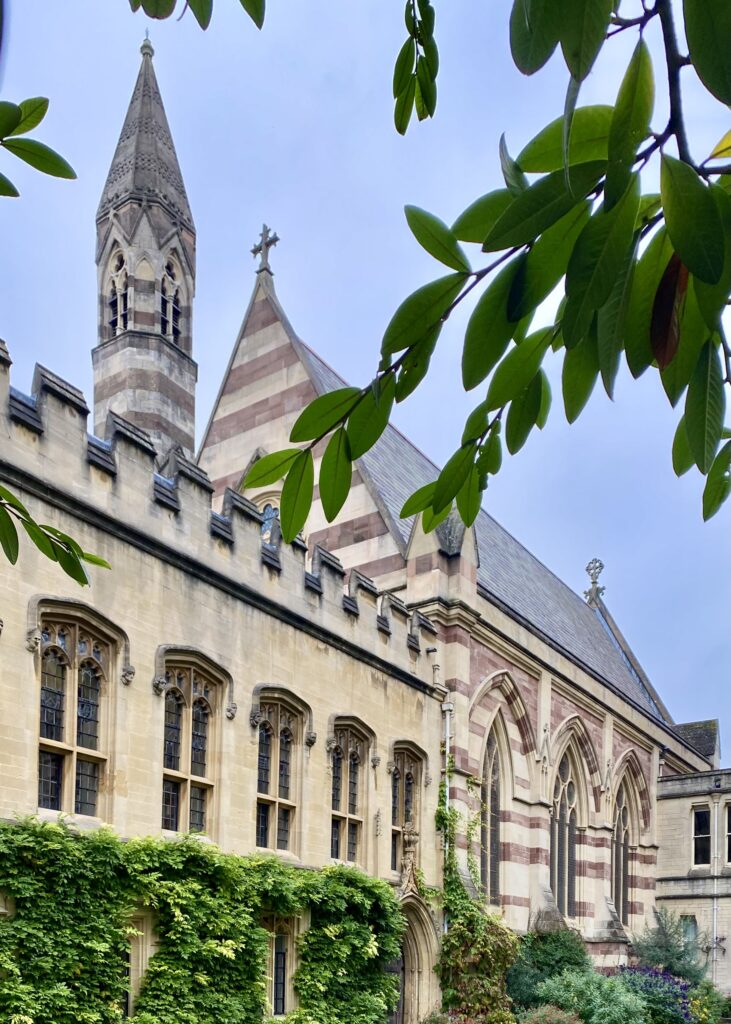
Balliol College chapel, a Victorian rebuild by William Butterfield, into which the much earlier Catherine window has been placed.
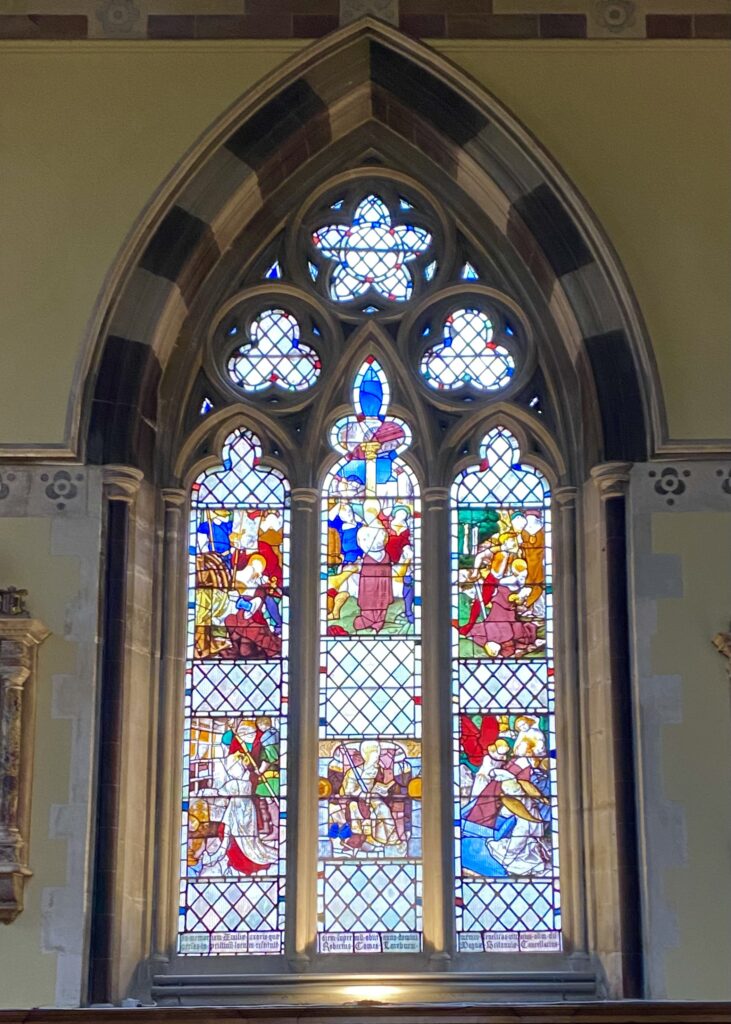
The Catherine window in Balliol chapel showing the main events in her story.
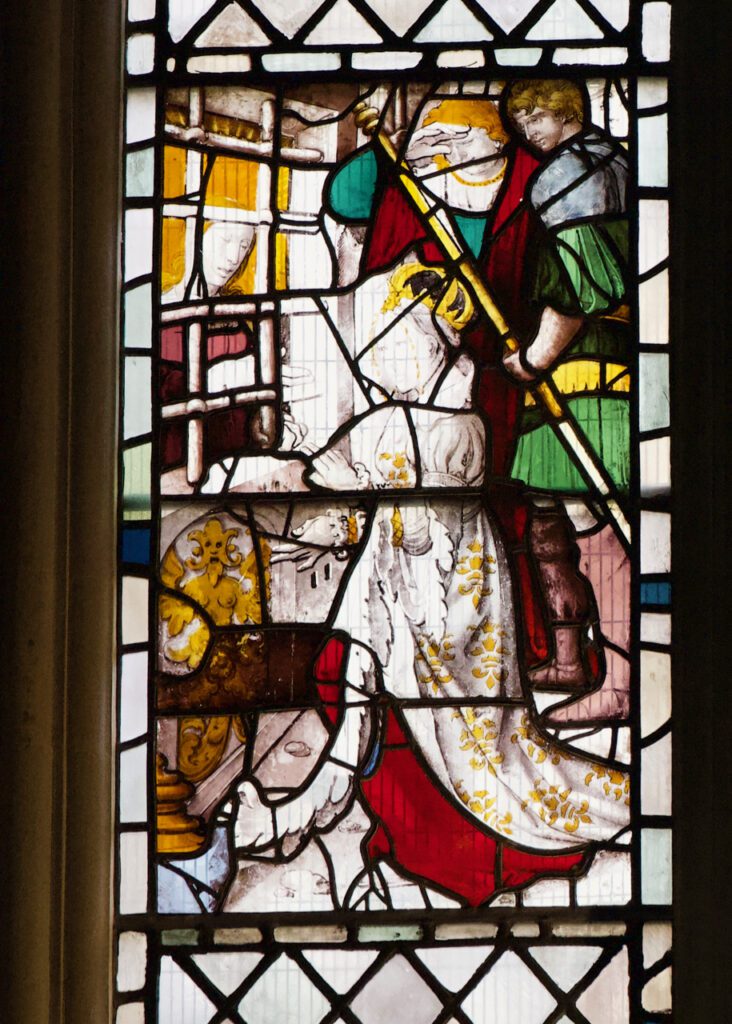
Catherine in prison being visited by the Empress, wife of Maxentius.
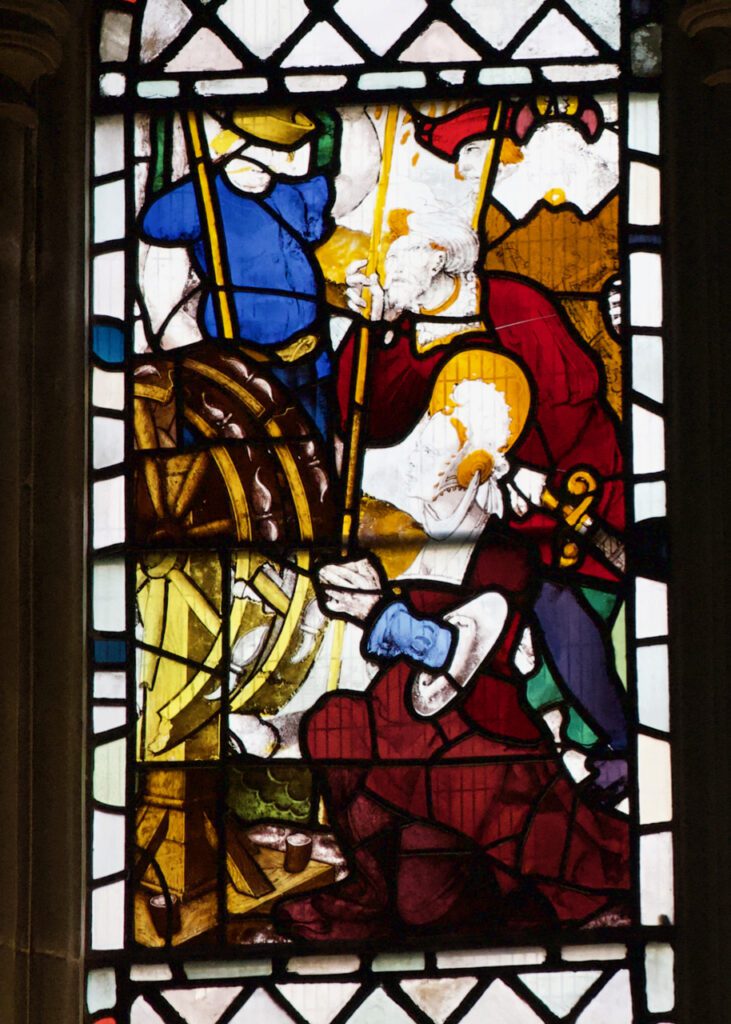
Catherine prays before the wheel which already begins to break apart. A soldier looks on in astonishment.
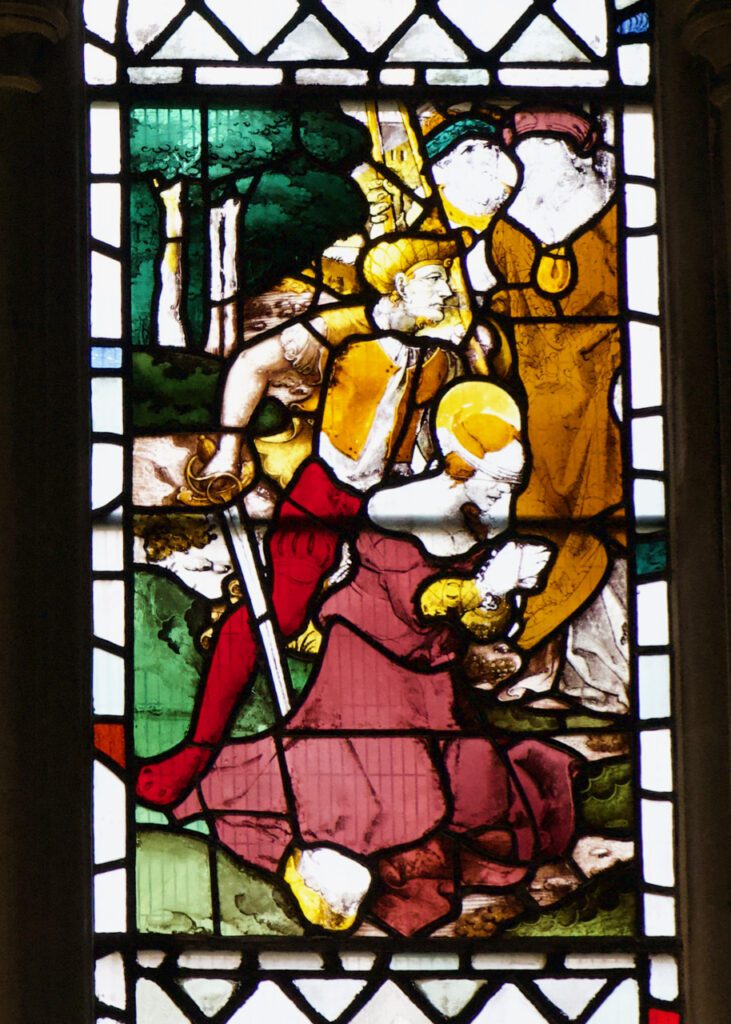
Her beheading.
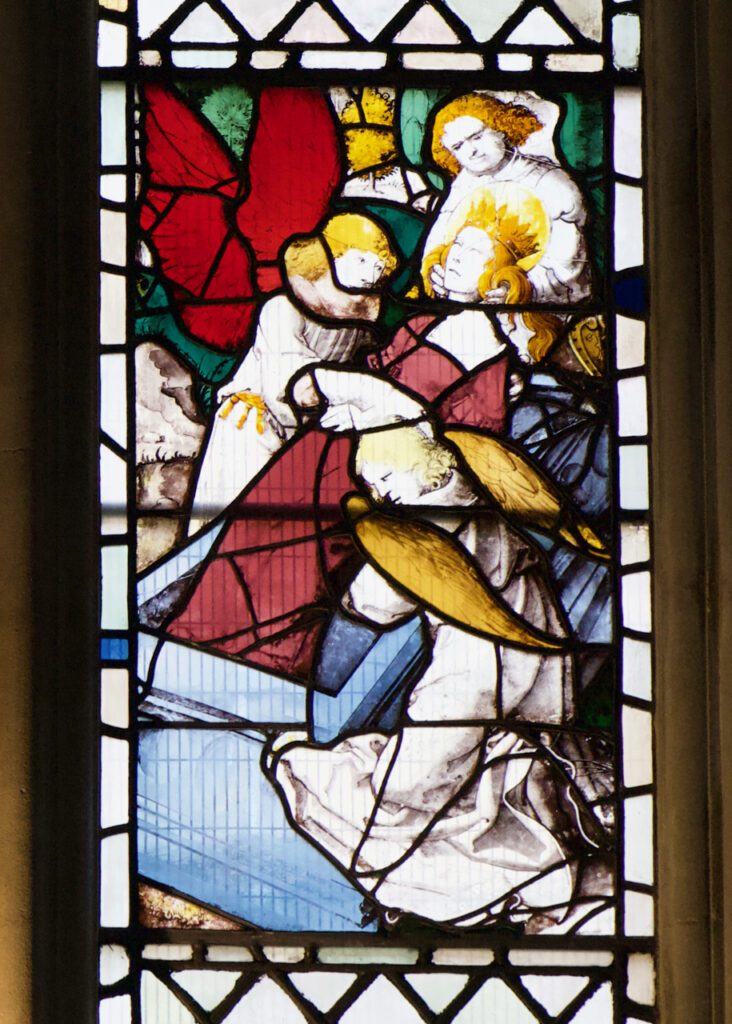
Reunited with her head on Mount Sinai.
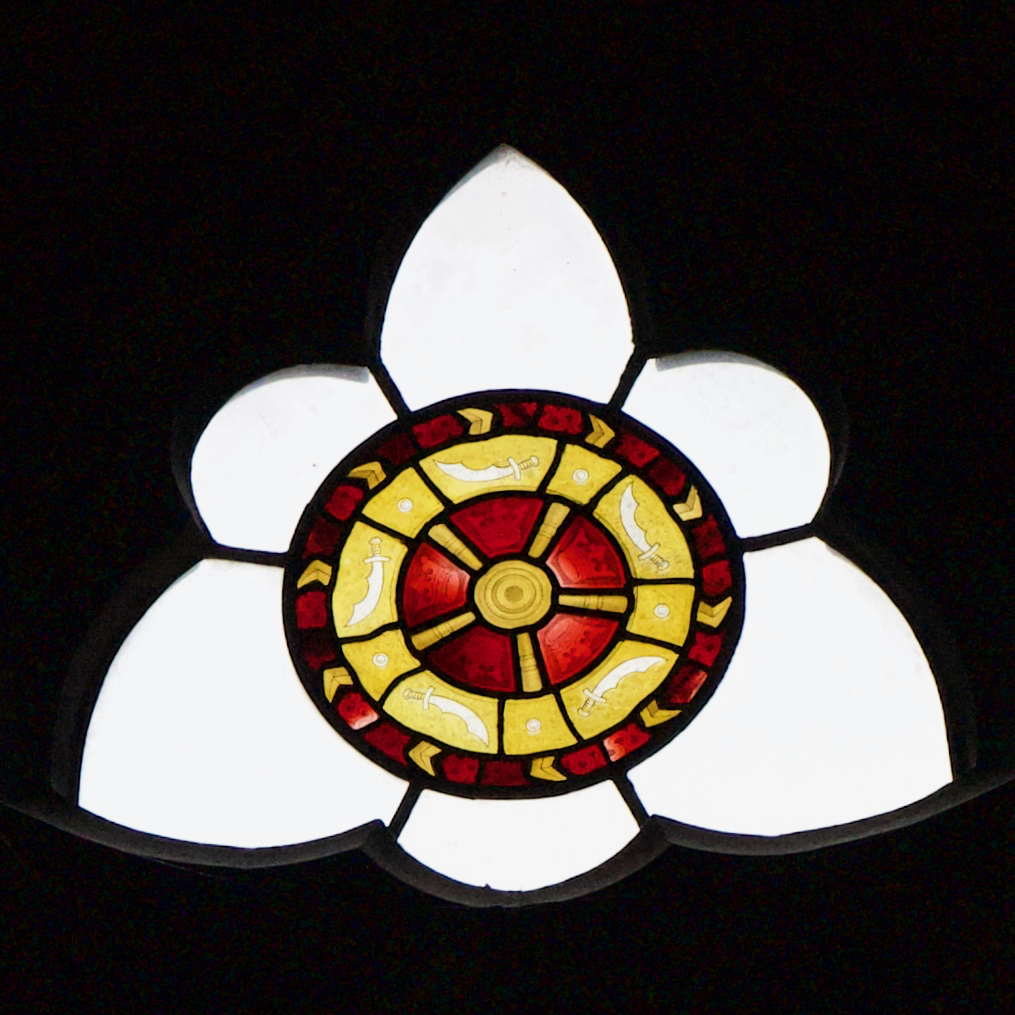
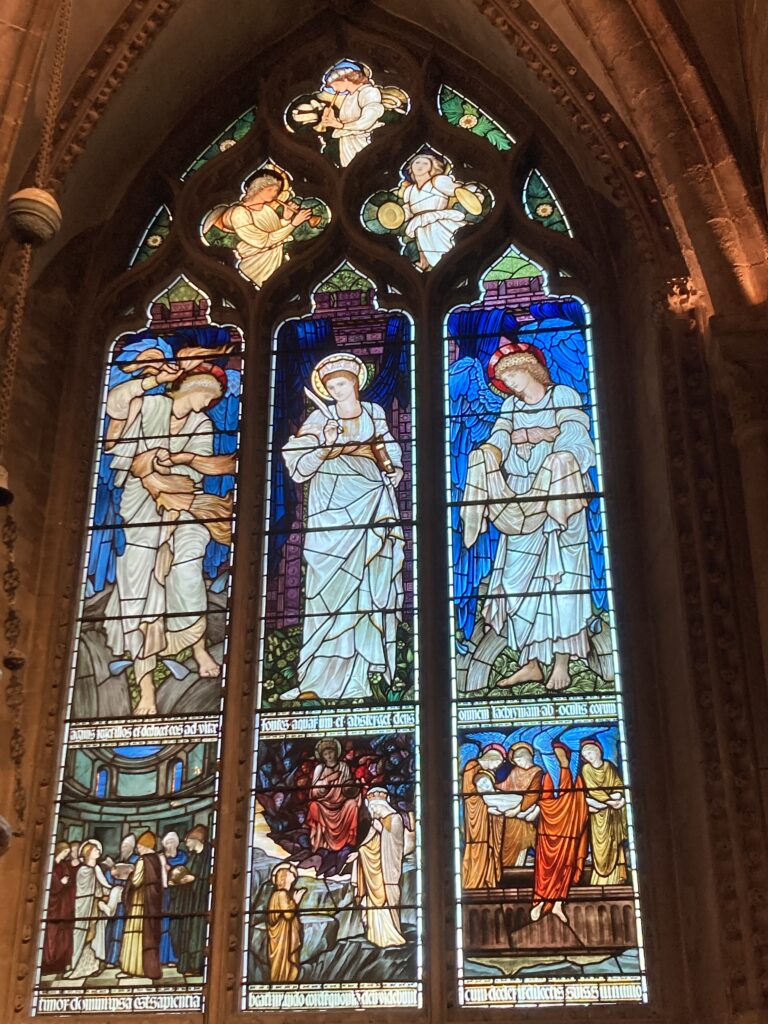
The Burne-Jones window at Christ Church Cathedral.

The face of St Catherine is copied from a portrait of Edith Liddell
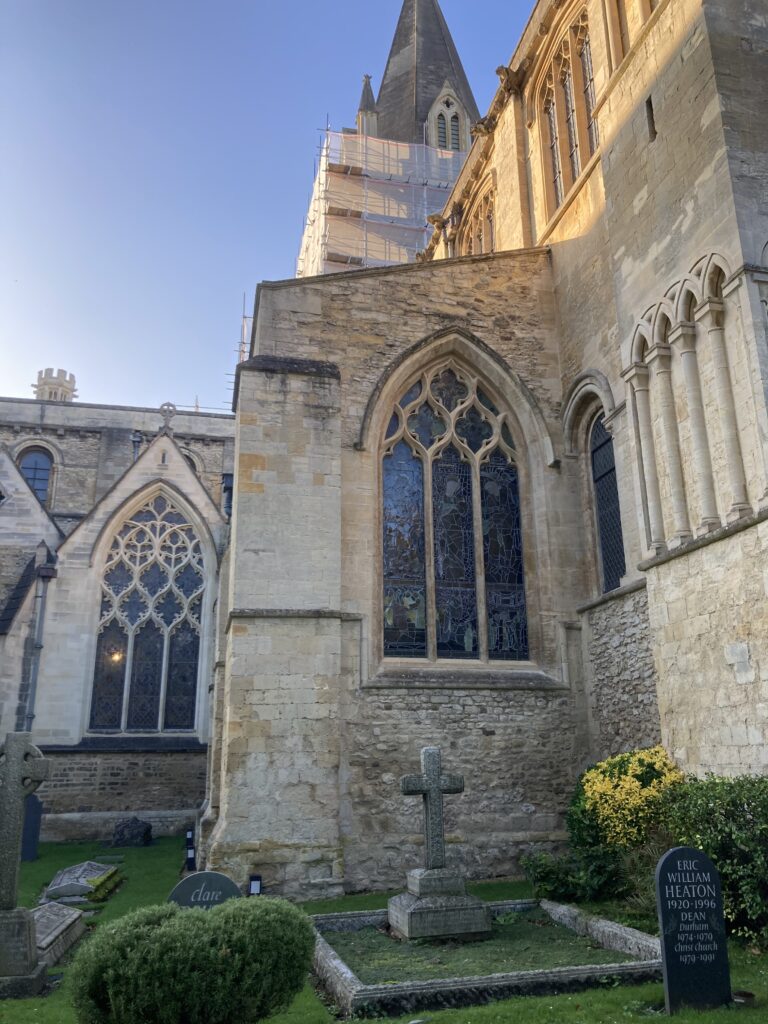
The Liddell family grave behind the Catherine (Edith) window.
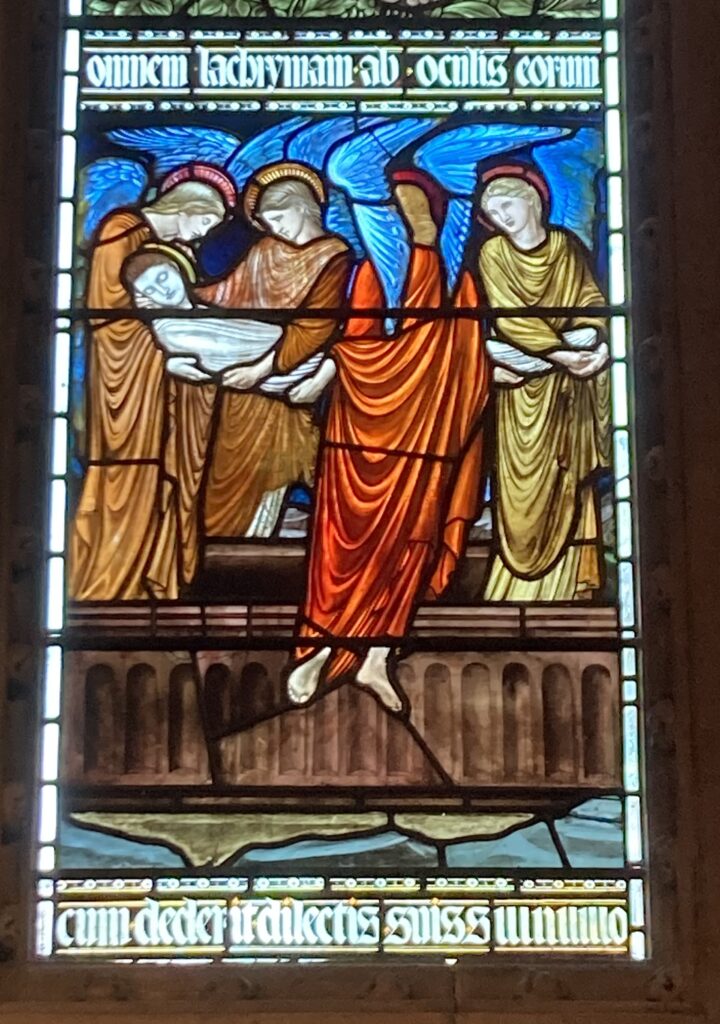
The Burne-Jones version of her arrival at Mount Sinai – again the angels are very careful to support her head.
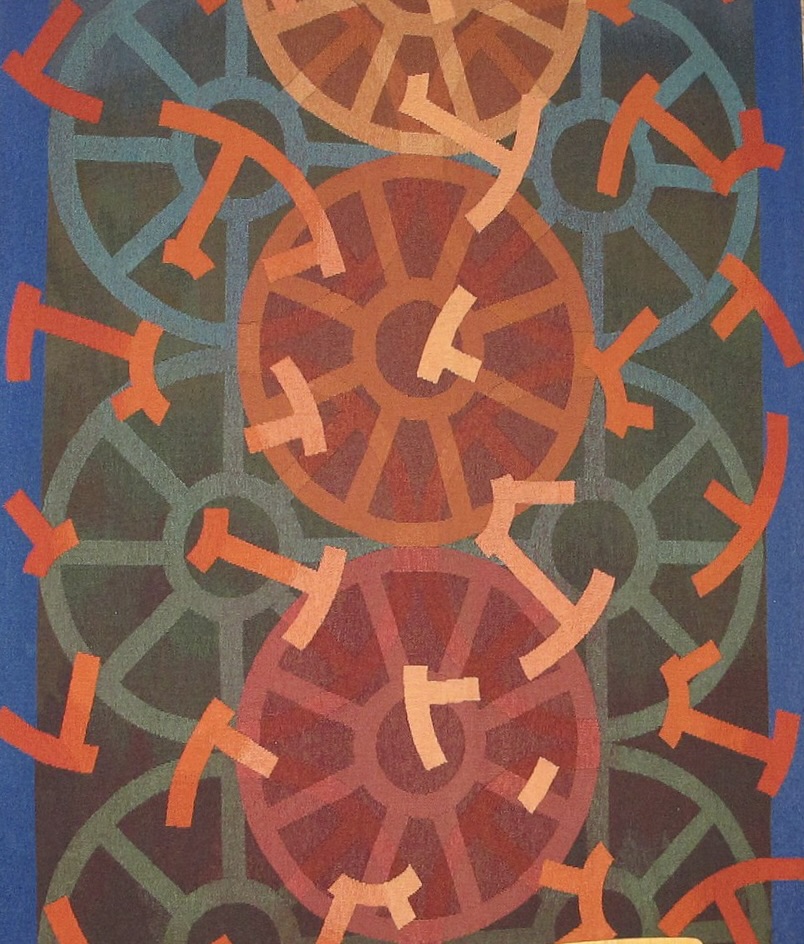
Broken wheels are the theme for Tom Philip’s tapestry (a small section shown here) that hangs in St Catherine’s College, Oxford.


Where wheels feature prominently in the heraldry too.

The octagonal building on Catte Street, thought to have once housed St Catherine’s Chapel, now known to have been that of St Mary at Smithgate.
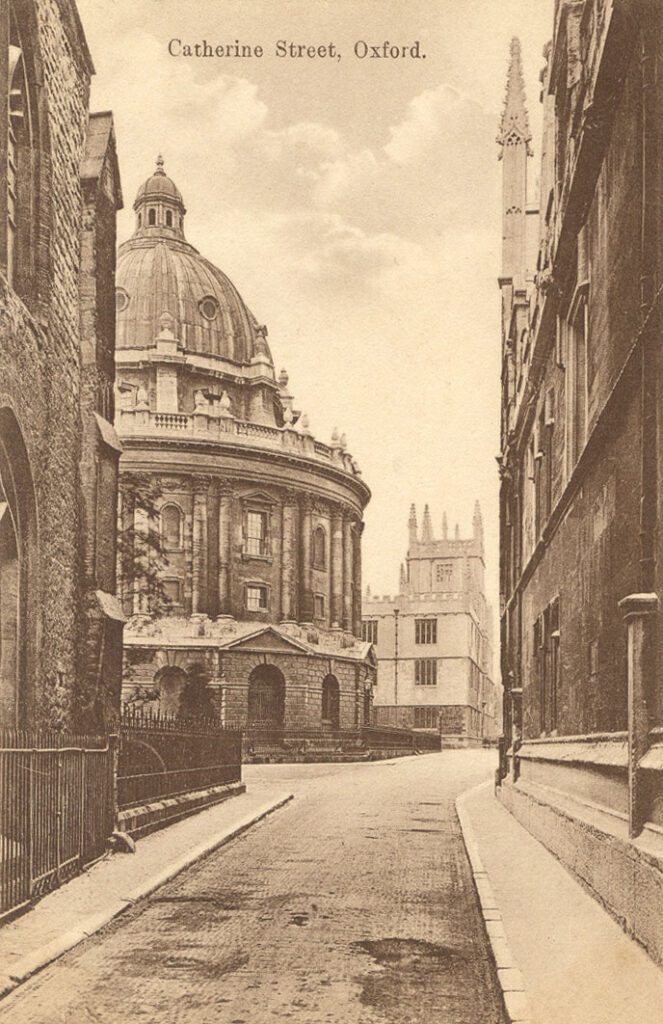
I was sent this postcard by Stephanie Jenkins who wrote:
“The street was known as Mousecatcher’s Lane in 1442, but was that just a nickname? I have narrowed down the dates when it became Catherine Street: the surgeon Samuel Vowles died in Cat Street in 1805, but his widow Jane Vowles lived in Catharine-with-an a Street in 1808. Cat was a diminutive of Catherine and that might be all there was to it, but maybe they thought it especially appropriate because of the chapel? It was still called St Catherine’s Chapel as late as 1895.
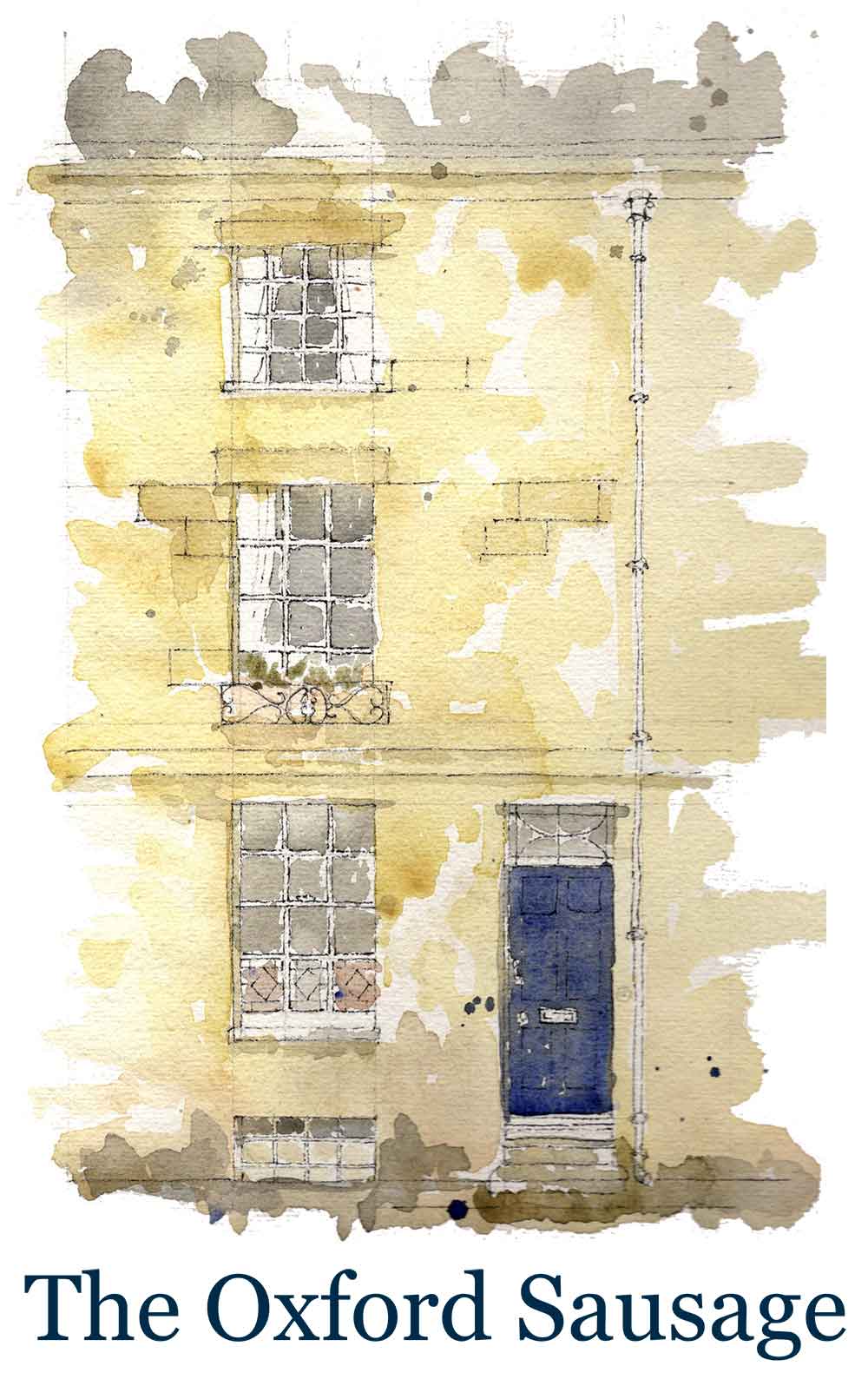
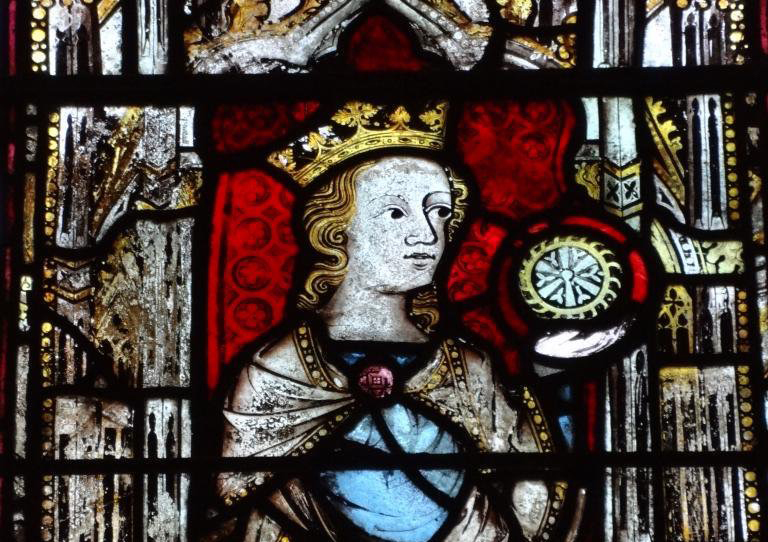
10 Comments
Join the discussion and tell us your opinion.
Fascinating. Hadn’t made the connection between Alexandria and Oxford. But it figures…
There is a lttle memorial plaque to 4 Oxford Catholic Martyrs on the house wall at the junction of Holywell and Longwall. Blessed Humphrey Pritchard, the only layman, is believed to have been a servant at the Catherine Wheel
Thanks ++++ for this wonderful essay
Excellent historic post on the topic of St. Catherine and the Wheel. I wondered if the ‘milk’ was acutally white light, back in the day …
Here is a link to an image of the Katherine’s Wheel Inn that was from the Master of Balliol’s residence. I found it in HE Salter’s 1913 book, ‘ Balliol College Deeds. ‘
HISTORIC OXFORD . 1828 Katherine Wheel along Magdalen Street East …

Great photography by John, once again
What a rich history! And excellent photos of the beautiful artworks the story generated.
She’s also the patron Saint of Librarians and Archivists (of which Oxford has a lot!)
How apt for Oxford.
Thank you. Your fascinating research has inspired me to find out more about my locality in North Yorkshire.
Catte or Cat Street in central Oxford (known as Mousecatcher’s Lane in 1442) was given the more respectable name of Catherine Street by 1817: do you think this was a nod to the nearby chapel? (It reverted to Catte Street in 1930, presumably to avoid confusion with Catherine Street in east Oxford.)
Excellent. A great read as always.